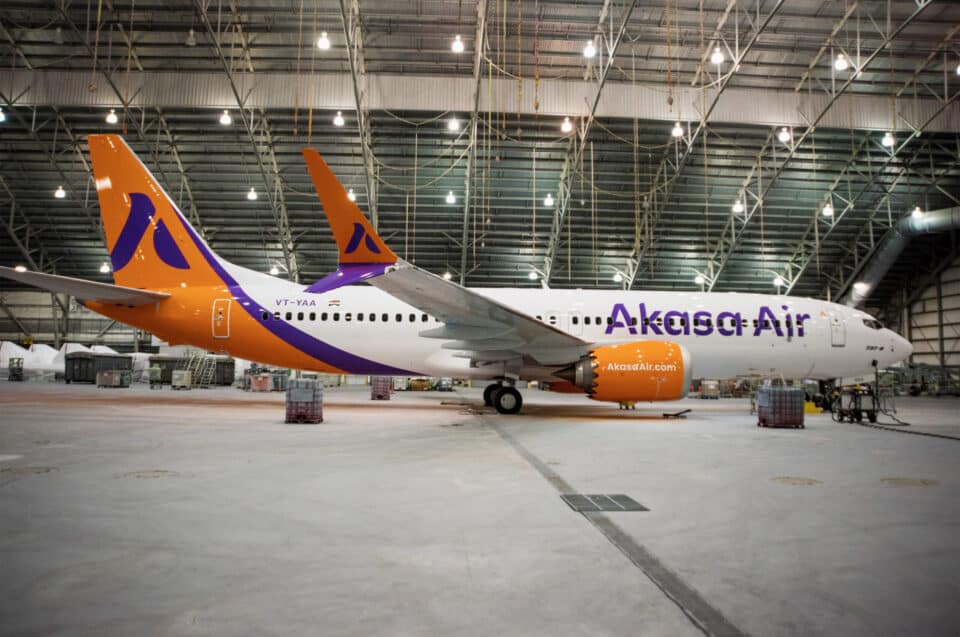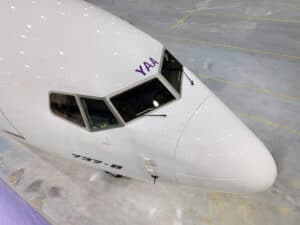Aerospace
The Livery of Akasa Air’s Boeing 737-800 Aircraft Has Been Revealed.

Akasa Airlines has revealed the livery for its first Boeing 737 MAX on Twitter. This airline will be another important milestone for India’s low-cost carriers. Akasa Air will be India’s most dependable airline, providing friendly and efficient service, dependable operations, and low pricing.
Stock market rogue Akasa Air, sponsored by Rakesh Jhunjhunwala, released a photo of its first plane on Monday. It posted a photo of the plane to a Twitter tweet with the caption: “Can’t keep calm!” Please say hello to our QP-pie!” “Coming soon to Your Sky,” it claimed in another tweet.”
To accommodate the growing demand across India, the low-cost carrier expects to start offering commercial flights in the summer of 2022, using its new fleet of 737s.
Can’t keep calm! Say hi to our QP-pie! ?#AvGeek pic.twitter.com/sT8YkxcDCV
— Akasa Air (@AkasaAir) May 23, 2022
Akasa Air is India’s newest airline, with the greenest and youngest fleet in the country, set to launch in the summer of 2022. A well-developed air transportation network that connects people, cultures, and places. Vinay Dube works closely with the Board of Directors as the company’s Founder, MD, and CEO in designing and implementing the company’s strategic, operational, and financial direction.
Akasa Air stated on November 16th, 2021 that it had placed an order for 72 Boeing 737 MAX aeroplanes to expand its fleet. At list pricing, it is worth over $9 billion. The 737-8 and the high-capacity 737-8-200 are among the two 737 MAX models included in the purchase. The 737 MAX will give Akasa Air a competitive edge in its dynamic home market, since it offers the lowest seat-mile costs for a single-aisle aeroplane, as well as high dispatch dependability and an improved passenger experience.
China’s first C919 passenger jet completes its first flight, Before delivery.
It announced the purchase of CFM LEAP-1B engines for its newly announced Boeing 737 MAX jets on November 17, 2021. At list price, the transaction is worth roughly $4.5 billion, which includes spare engines and a long-term servicing agreement. The revolutionary LEAP engine from CFM continues to set industry benchmarks in terms of fuel efficiency and asset utilization. When compared to the top CFM56 engines, the fleet offers superior fuel efficiency, fewer CO2 emissions, and a considerable reduction in noise.
Akasa Air Orders 72 Fuel-Efficient 737 MAX Airplanes to Launch Service in Fast-Growing Indian Market
The much-anticipated brand identity of Akasa Air was launched on December 22, 2021, with the demonstration of its ‘Rising A’ emblem and tagline, ‘It’s Your Sky.’ The elements of the sky have influenced the Rising A. It represents the rising sun’s warmth, a bird’s simple flight, and an aircraft wing’s dependability. ’It’s Your Sky’ is the brand’s commitment to accept everyone and offer a positive atmosphere for all People, regardless of socioeconomic or ethnic backgrounds. As a result, Akasa Air will be India’s most trustworthy airline, providing friendly and professional service to the customers, dependable operations, and low pricing.
Boeing issued immediate response on 16 B737 MAX customers
On Monday, Akasa Air announced that it expects to acquire its first Boeing 737 Max plane by the middle of June and begin commercial operations in July. The airline posted photos of its first Max plane from the Boeing production factory in Portland, Oregon, on Monday as it prepares for delivery.
“The airline has confirmed its intention to receiving its first aircraft in India by mid-June and to begin commercial operations in India by July 2022,” according to the statement. It expects to operate 18 aircraft over internal routes in the country by the end of March 2023, with a concentration on metro to tier-2 and tier-3 cities, according to the company.
Vistara and Air India are in talks to be merged by Tata Sons and Singapore Airlines.

Aerospace
Boeing Transfers Rocket Stage to NASA, Paving Way for Human Moon Mission

Boeing has achieved a significant milestone by providing NASA with the second core stage of the Space Launch System (SLS) rocket.
This crucial component, crafted at NASA’s Michoud Assembly Facility (MAF), is set to propel the Artemis II crew into lunar orbit, marking humanity’s return to deep space after a 50-year hiatus.
The monumental Boeing-built rocket stage, the largest element of the Artemis II mission, will embark on a journey aboard the Pegasus barge, traveling 900 miles to NASA’s Kennedy Space Center.
Comparison of two legendary aircraft B777x vs B747 aircraft:Click here
Upon arrival, it will be meticulously integrated with other essential Artemis II components, including the upper stage, solid rocket boosters, and NASA’s Orion spacecraft within the iconic Vehicle Assembly Building. This intricate integration process is a vital step toward the eagerly anticipated Artemis II launch, slated for 2025.
“Boeing-built products helped land humankind on the moon in 1969, and we’re proud to continue that legacy through the Artemis generation,” remarked Dave Dutcher, vice president and program manager for Boeing’s SLS program. “Together, with NASA and our industry partners and suppliers, we are building the world’s most capable rocket and paving the way to deep space through America’s rocket factory in New Orleans.”
NASA, Lockheed Martin Reveal X-59 Quiet Supersonic Aircraft:Click here
The delivery of Core Stage 2 marks a significant achievement in the evolution of the SLS rocket. Towering over 200 feet and powered by four RS-25 engines, this core stage, coupled with two solid-fueled booster rockets, will generate a staggering 8.8 million pounds of thrust. This immense power is crucial to launching Artemis II and future missions into the vast expanse of space.
The SLS rocket stands unparalleled in its capability to transport both crew and substantial cargo to the moon and beyond in a single launch. Its extraordinary capacity will facilitate the delivery of human-rated spacecraft, habitats, and scientific missions to destinations including the moon and Mars, ushering in a new era of space exploration.
-

 Travel1 week ago
Travel1 week agoAir India to Expand US Operations with Three New Routes After a Decade
-

 Travel2 weeks ago
Travel2 weeks agoWhy We Should Avoid These Stamps in a Passport
-

 Airlines1 month ago
Airlines1 month agoInvestigations Reveal Fake Chinese Titanium in Boeing and Airbus Jets
-

 Tech4 weeks ago
Tech4 weeks agoChina’s CATL Plans 1,800-Mile Electric Plane Launch by 2027
-

 Airport3 days ago
Airport3 days agoTop 10 Largest Airports in the World by Size
-

 Aerospace4 weeks ago
Aerospace4 weeks agoChina’s Fighter Jets Turn Wings into Autonomous Drones
-

 Airlines4 days ago
Airlines4 days agoAir India Rolls Out A350s for Delhi-New York JFK and Newark Routes
-

 Defence3 weeks ago
Defence3 weeks agoBoeing Enhances Chinook with New Engines and Block II Upgrades at $96 Million








